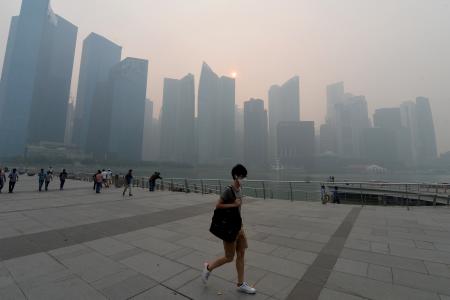Local volunteer group plans to go after firms involved in causing haze
Local volunteer group plans to go after S'pore-registered firms involved in starting fires in Indonesia
As the season of haze returns to our shores, some Singaporeans may feel helpless about the smoky, unhealthy air blown our way from the south.
But a group of volunteers are determined to take up the fight against the haze, or those who had a hand in causing it.
The Haze Elimination Action Team (Heat), led by Professor Ang Peng Hwa of Nanyang Technological University's Wee Kim Wee School of Communication and Information, is planning to sue and boycott the companies responsible for the fires.
Yesterday morning, PSI levels crossed into the hazardous range. At 6am, the 24-hour PSI was 257-318, and the three-hour PSI stood at 334.
Prof Ang told The New Paper yesterday: "We want consumers to know that there is something that we can do. We are not helpless."
He and a few others set up Heat in 2007 - a year after Singapore experienced its worst haze in a decade, with the Pollutant Standards Index (PSI) peaking at 150.
"What struck me most back then was when I read about a 40-year-old CEO who said how Singaporeans can't do anything about the haze.
"This was a man empowered and in charge of a company, yet he was feeling helpless. I told myself that surely there was something we can do," he said.
In 2007, Heat raised about $20,000 for a website and an educational effort in Jambi, South Sumatra.
Today, the group has about 800 members who include professionals, housewives and students.
It is also working with another haze awareness group, PM.Haze.
Prof Ang said that Heat intends to sue and boycott companies that are registered here but are involved, via intermediary or subsidiary companies, in starting the fires in Indonesia.
It is also "looking for someone or an organisation that has incurred losses of at least tens of thousand dollars or more due the haze", or who has been hospitalised, to be an "ideal plaintiff", he said.
Legal fees are estimated between $50,000 and $100,000 and the team is looking to get pro bono help as well as a lawyer with experience in corporate forensics to help trace the ownership pattern of the fires, he said.
Singapore Management University law don Eugene Tan said that this was an encouraging effort at self-help by Heat, but added that it would be a challenging task.
TOUGH TO PROVE
Firstly, there is the evidential burden of proof that these local companies have management control of the Indonesian companies that are legally responsible for the haze, he said.
Heat would then need to provide evidence to the court that these Indonesian entities were indeed causing the haze pollution, he said.
But he noted that this bottom-up approach, if successful, would hit the alleged companies where it hurts the most - their reputations and profits.
"It will send a signal to these companies to clean up their act. It can pressure Singaporean entities to insist on sustainable and responsible agricultural practices throughout their supply chains.
"It's a case of consumers having a big say in how a company ought to conduct itself and being responsible to stakeholders," he said.
Environment and Water Resources Minister Vivian Balakrishnan said during a press conference yesterday that the Transboundary Haze Pollution Act, which was passed in Parliament last year, will help those seeking legal action against those responsible for causing or condoning fires if burning results in unhealthy levels of haze in Singapore.
"Whenever possible, we will try to share as much information as possible with the public. I think they are entitled to take action. I think our demands for greater transparency and sharing of information will facilitate their action. Anyone who suffers losses as a result of this may be entitled to take action against errant companies pursuant to (the Act)."
Dr Balakrishnan also listed five companies that the National Environmental Agency has issued notices to. (See report,)
Prof Ang said the case could take years to build and is aware of the challenges ahead.
One of their plans is to gather pictures of the sites that are burning now and check back on these sites in a few years.
"We hope then to trace who benefited from these fires. To the companies suspected of starting fires, we are coming after you," he said.
NEA serves notices on five Indonesian firms
The National Environmental Agency (NEA) has initiated action against four companies which might be involved in the fires that have resulted in the haze, under the Transboundary Haze Pollution Act.
Minister for the Environment and Water Resources Vivian Balakrishnan told reporters yesterday: "It (the haze situation) cannot be tolerated. It has caused a major impact on the health, society and economy of our region."
NEA investigations showed that haze-causing fires may have occurred on land concessions held by four Indonesian companies: PT Rimba Hutani Mas, PT Sebangun Bumi Andalas Wood Industries, PT Bumi Sriwijaya Sentosa and PT Wachyuni Mandira.
Under the Act, NEA asked the companies to carry out measures such as extinguishing or preventing any fires on land owned and occupied by them, discontinuing or not commencing burning activities and submitting to it a plan to extinguish or prevent recurrence of such fires.

NEA has also served notice to Asia Pulp & Paper Company, an Indonesian company with an office in Singapore, asking for information on its subsidiaries, as well as measures taken by its suppliers in Indonesia to put out fires.
All five notices were served yesterday.
NEA has also written to the Indonesian authorities asking for the names of other errant companies which might have been identified as causing the fires.
Dr Balakrishnan added: " The Singapore Government is examining ways to apply more economic pressure against errant companies. We will share the results of investigations with public whenever possible."
The maximum fine for companies found guilty of starting fires is $100,000 per day, capped at $2 million.
Q&A To clear the air
It looks clear outside and there is no smoke smell, but the PSI levels on the National Environmental Agency (NEA) website are above 300. What should I trust?
The public should not depend on the visibility and smell of the air because there are other contributing factors in the air besides the PM2.5 concentration, said an NEA spokesman.
Members of public should instead look at the three-hour PSI reading and the one-hour PM2.5 concentration level as a guide to adjust immediate activities like going outside for a jog.
"Don't trust your eyes and nose because they are not what detect harmful substances in the air," said air pollution researcher Erik Velasco of the Singapore-MIT Alliance for Research and Technology's Centre for Environmental Sensing and Modelling.
Is the online site www.aqicn.org reliable?
On Sept 18, the Beijing-based environmental non-profit group Air Quality Index China released a real-time, interactive map displaying air pollution levels around the world.
The AQICN map, which automatically updates every 15 minutes, compiles verified data from official environmental protection agencies such as NEA.
But its values may differ from those on the NEA website because of a difference in the formula that it uses to calculate the PSI.
Dr Velasco said the NEA website is based on instruments that are approved by international standards and it would be safer to refer to it.
Which is a better gauge, the PSI or PM2.5 readings?
The 24-hour PSI forecast reflects the PSI trend. It is also a gauge for an individual's total exposure to PM2.5 concentrations and should be used to plan ahead for activities, such as whether one should go to work or school. During haze episodes, health advice will be based on the 24-hour PSI.
The three-hour PSI reading and the one-hour PM2.5 concentration reading are based on more recent PM2.5 readings than the 24-hour PSI forecast. So these readings are better guides as to what one should do at a particular point of the day.
What is expected of the haze for the new few days?
The hazy conditions will continue over the next few days, but will gradually improve over the weekend, said NEA.
Wind patterns are expected to change - coming from the South-east instead of the South-west, where the fires and smoke are, Dr Velasco said.
Get The New Paper on your phone with the free TNP app. Download from the Apple App Store or Google Play Store now




